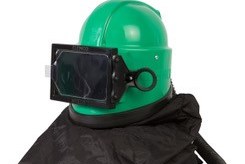Safe Abrasive Blasting During the COVID-19 Pandemic
Clemco’s Director of Safety shares safe abrasive blasting and cleaning tips for working during the COVID-19 pandemic.

Source | Clemco
Worksite safety is essential under normal circumstances, but there are extra precautions you can take to stay safe and healthy during the novel coronavirus pandemic. Clemco Industries Corp.’s (Washington, Missouri) director of product safety Thomas Enger has published some recommendations for safe abrasive blasting.
Featured Content
Precautions When Using Abrasive Blast Machines
After using a blast machine, clean and disinfect:
- Hose
- Remote controls
- Abrasive metering valve
- Isolation valves
- Bags of abrasive that you touched and have not discarded. (Keep moisture from entering the bags)
- Any other part of the machine you may have touched
- Any blast machine surface you may have leaned against with bare skin or clothing
- Any other surfaces you may have touched
Precautions When Using Blast Cabinets
After using a blast cabinet, clean and disinfect:
- Switches
- Latches
- Regulators
- Wing nuts
- View window exterior (You, and probably others, have breathed on it.)
- Any other part of the cabinet you may have touched
- Any blast cabinet surface you may have leaned against with bare skin or clothing
Precautions When Using Blast Rooms
After using a blast room, clean and disinfect:
- Door handles
- View windows
- Brooms
- Shovels
- Any other tools or parts of the blast room you may have touched
- Any blast room surface you may have leaned against
- Any part of the blast machine you may have touched, such as:
- Hose
- Remote controls
- Abrasive metering valve
- Isolation valves
- Bags of abrasive that you touched and have not discarded. (Keep moisture from entering the bags)
- Any other surfaces you may have touched
General Precautions
For blast suits and gloves:
- Clean and disinfect the exterior of your blast suit and gloves
- As best you can, clean and disinfect the interior of your blast suit and gloves and dry them. Air drying may be the easiest
- Don’t share blast suits and gloves!
Dry surfaces you cleaned with disposable rags:
- If you cannot let equipment air dry, it is important to dry the equipment with disposable rags because the coronavirus can live longer in moist environments. Furthermore, mold can grow in moist environments
- Throw away rags after using them
For respirators, use one of two ways to clean after use:

- To Hand Wash a Respirator and its components:
- Break it down into its individual parts, including the suspension system, in-helmet-mounted carbon monoxide monitor if you use one, inner lenses, rubber gaskets, cushions, the cape collar, blast shroud, and other components in or attached to the helmet.
- Hand wash the blast helmet and its components with a 2% bleach solution or another CDC recommended disinfectant.
- Allow the helmet and components to air dry.
- To Clean by Submerging a Respirator and its Components:
- Detach fabric components, cushions, the cape collar and blast shroud, and the in-helmet-mounted carbon monoxide monitor, if you use one, from the respirator.
- These detached components should be hand washed and then allowed to air dry.
- The cushions can be replaced instead of washed. Clemco does not recommend submerging a cushion suspension system.
- Submerge the blast helmet with the components that are attached to it in a 2% bleach solution or another CDC recommended disinfectant.
- Gently agitate the blast helmet with its attached components for at least 5 minutes.
- Remove the helmet with its attached components from the solution and allow to air dry.
Learn more at clemcoindustries.com/covid19-update.


















